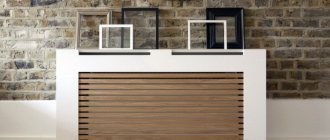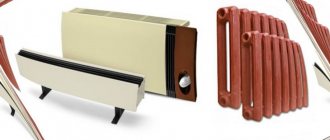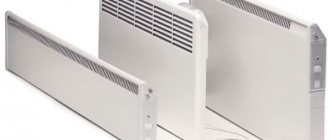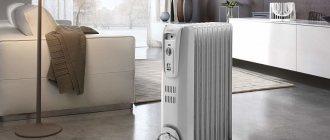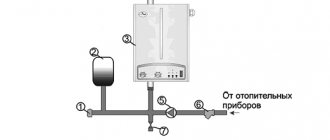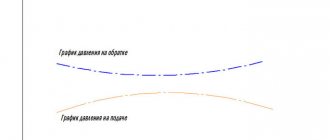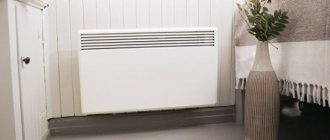The reason for installing electric heating devices in private houses and apartments is often the inability to choose an alternative source of coolant. Gas is not always and not available everywhere, and specially ordering firewood for premises where the owners occasionally live is not always rational.
Therefore, despite the high cost, and electricity is a very expensive source of heat, we have to look for heating devices that meet both the requirements of efficiency and economic feasibility. Today, among electric heating systems, preference is given to convectors and heating boilers, although the question of which type of appliance is more reasonable to install in the house is worth seriously understanding.
Electric boiler and convector - what is the operating principle of heating devices
For both the electric boiler and the convector, the main power source is household electricity at 220 or an industrial network at 380 volts. The operating principle of the convector is based on the principle of movement of air masses when they are heated. The structure of the convector consists of two parallel metal plates, between which a heating element is installed. When the device is turned on, the heating element heats up, from which the air between the metal walls of the convector begins to heat up. As the air heats up, it rises, sucking in a new portion of cold air. The heated air, gradually cooling, falls down and is again sucked into the cavity of the convector.
An electric heating boiler uses a slightly different principle of heating a room. The main heating element of an electric heating element is a liquid coolant - water or antifreeze. When heated, it rises through the boiler cavity and enters the heating system, where it is carried through pipes to the heating radiators. When cooled, the coolant releases energy to the air, and thus heats the room.
What types of electric convectors are there?
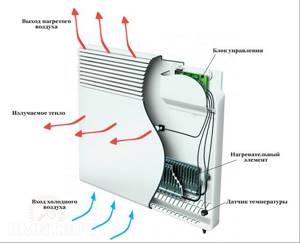
Almost all electric convectors are identical in design - housing, heating element, control board, power cord, wall mounting bracket or platform if wall mounting is not provided.
The difference begins in the details - primarily in the features of the heating element. The simplest models have a coil as a heating element, which begins to heat up when voltage is applied.
More modern models have a dry or ceramic heating element as a heating element, when heated, the air does not dry out as is the case with a spiral and does not require additional humidification.
The second important point is the difference in control equipment - the thermostat and the control board. Simple models are equipped with a conventional thermostat, which is controlled by a mechanical thermostat. The accuracy of setting the required temperature is approximate; a mechanical thermostat is simply unable to provide high accuracy.
The most modern models of convectors not only have an electronic display, but can also be programmed to turn on automatically at the right time. Such models are equipped with smart home systems, which are controlled by sending commands from a smartphone. Such convectors allow you to more accurately calculate the temperature in heated rooms, which makes it possible to save energy resources.
The strengths of electric convectors are:
- Low cost of equipment;
- Easy to install and operate;
- Possibility of using a regular electrical network;
- Quick heating of the room.
Among the disadvantages it is worth noting:
- High electricity consumption;
- Difficulty in setting the temperature on cheap models;
- Feeling of dry air in a heated room.
"Dry" heating
If the two options described above (in the maximum configuration) require large investments in equipment, then this scheme is much simpler and cheaper. This is a waterless heating system that does not require a boiler room. The main equipment is inverter convectors. Simply put, these are electric heaters equipped with an inverter control unit, which allows you to smoothly regulate the heating power.
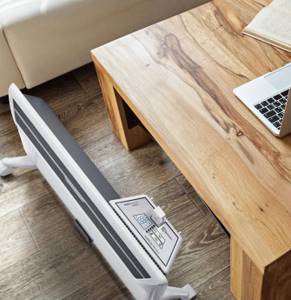
Photo: www. home-comfort.ru
A conventional convector operates on the “on/off” principle. Inverter ones work differently. As soon as the device heats the room to the set temperature, its “brains” give the command to reduce the heating power. The convector does not turn off the heating; instead, it begins to reduce the intensity of the heating element. The latter continues to work only to maintain the desired temperature, so it is believed that the inverter convector consumes less energy. According to the product description, this allows you to reduce electricity consumption by 3 times.
For the object of interest to us, four wall-mounted and three “plinth” convectors (220 mm high) with an inverter control unit were proposed.
Let us recall that electric convectors operate absolutely without water, which means that there is no need to provide measures for protection against freezing in the event of a lack of electricity, which lead to an even greater increase in the cost of the first two systems.
Instead of water heated floors, they offered electric ones, and for the bathroom - two electric heated towel rails (135 W each).
In order to be able to remotely control convectors (as well as hot water boilers and heated electric floors), the system was supplemented with a removable control module. It allows you to make individual settings for each zone (room) from your smartphone through a mobile application.
The cost of all equipment is 3830 rubles. According to preliminary calculations, if you don’t believe marketers about saving electricity with inverter convectors, the cost of electricity for heating will be 969.45 rubles/year (as is the case with an electric boiler).
Types of electric boilers and their features
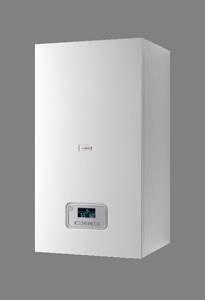
When comparing whether an electric boiler or convectors is more profitable, it is necessary to take into account not only the technical characteristics, but also the specifics of constructing a heating system with coolant circulation. The electric boiler provides heating of the coolant, after which it begins to circulate through the system.
The design of the simplest electric boiler ensures heating of water in the circuit by turning on an electric heating element. Water or antifreeze heats up and expands in volume, movement begins - the hot coolant is supplied through the pipes into the system, and the cooled coolant is directed into the boiler cavity. In the cheapest electric heating boilers, the heating element directly heats the coolant, and movement is carried out by gravity. It is worth noting that this is not the most reliable type of electric boiler. If the heating element fails, there is a high probability of electric shock, especially if metal radiators are used as batteries. But on the other hand, these boilers can compete with mid-price convectors in cost and reliability.
Electrode heating boilers differ from devices using heating elements in that it is not the heating element that is immersed in the coolant, but the electrodes. Electrodes provide fast heating of water, with less electricity consumption. These are safer devices, since they are equipped with a safety system that turns off the power supply to the electrodes in the event of a coolant leak or its temperature rising above the set one.
The new generation of heating boilers are induction heating devices. This is a new type of heating boilers with high efficiency and high safety. The advantage of this type of boiler is the absence of direct contact of the heating elements with the coolant. True, such pleasure is far from the cheapest.
Which is more profitable and economical to operate?
Which warm floors are better and will cost less during operation is a question often asked by owners of private houses.
If we consider from the point of view of the price of the coolant, then water ones are definitely more economical. Heating the liquid inside the pipes will be much cheaper, especially if you have a gas boiler.
The price of energy that powers electric floors is steep, although with proper use of a thermostat, you can save on energy resources.
When comparing water and electric floors in terms of repair and maintenance costs, we can say that the cost of repair work in case of cable damage is lower than pipeline repair. And if water floors are laid on the second floor of the cottage, then if there is a serious leak in the circuit, the room below will need to be repaired.
Principles of constructing a heating system using convectors and electric boilers
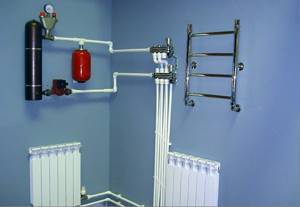
The advantage of both heating systems, whether using a boiler or using a convector, is that installation and installation do not require obtaining permits. The exception is the installation of heating equipment with a power of more than 10 kW.
In addition, such a system can be installed without agreement with the energy supply company, if the total power of all consumers does not exceed the power allocated to a separate household or apartment. When calculating the required power consumption, when selecting convectors it is worth using the rule that for every 10 sq. meters of room area require the installation of devices with a power of at least 1 kW. Thus, the room is 12-14 sq. meters it is necessary to install a convector with a power of 1.5 or 2 kW.
When comparing whether an electric boiler or convectors is more convenient, it is reasonable to pay attention to how the rooms will be heated. Individually installed convectors essentially act as autonomous heating systems with an individual control unit. Therefore, by adjusting the air temperature in each individual room, it is possible to significantly reduce energy consumption. This option is recommended for use when heating a room in which people will live all year round. On the other hand, electric heating with convectors of premises with temporary occupancy will be more expensive, since it will require additional equipment to control the temperature during the period of absence of people.
As for the electric boiler, in order to maintain the required temperature conditions, no additional costs are required for connecting the control unit. But there are many more options to save money during the heating season. First of all, a coolant heating system allows you to equalize the temperature in all rooms. The air warms up evenly and does not dry out. With such a system, the building itself is less susceptible to temperature changes during the heating season, and there is an opportunity to save money. Simply, when installing radiators, it is necessary to use control and shut-off valves, with the help of which the temperature of the coolant in the batteries is regulated.
Having assessed which electric boiler or convector is better when used in an autonomous heating system, it is necessary to take into account the costs of laying communications. If we take into account the power consumption of convectors for a small private house, then it is likely that the stationary electrical wiring simply will not withstand the simultaneous switching on of all devices. Therefore, to connect devices with a total power of 6-8 kW, it is necessary to lay a separate power supply line to each connection point.
To install the boiler, in addition to laying wires, you will need to lay out pipes and install radiators, an expansion tank, take into account the cost of shut-off valves and safety devices.
Economic indicators and comparison of heating devices
What is more economical: a boiler or an electric convector? It is worth noting that both the first and second options are energy-consuming. But actual costs are affected by the area of the room, the size of heat loss, and the characteristics of a particular device. The average calculations for both devices are approximately equal: an area of 20 m² will require 2 kW of power, and a house of 100 m² will require at least 10 kW, which will equal approximately 240 kW per day.
Analyzing the characteristics of electric boilers, we can conclude that this type of heating system is similar to the usual one, as in multi-storey buildings, and is stationary. The costs and time for laying the pipeline will only be required once, after which the established system will not require special manipulations. But such a system is not mobile; the convector can be moved or turned off, unlike an electric boiler. The pipeline, theoretically, can be optimized and additional valves installed to close the coolant circulation. In practice, this is quite difficult to achieve. The boiler is also unsuitable for small rooms.
Convector heating systems have no problems with the organization of work, and have virtually no disadvantages. The user can choose both a budget and a decorative model. The downside is that they do not have a single control center; more precisely, it must be purchased and configured separately. Walking around rooms, setting up and adjusting several units, checking and maintaining them in working order - all this will at least take up time every day.
In practice, users usually use convector heaters as a temporary and simple solution until a permanent heating network is installed. Later the devices serve as additional or emergency heating.

